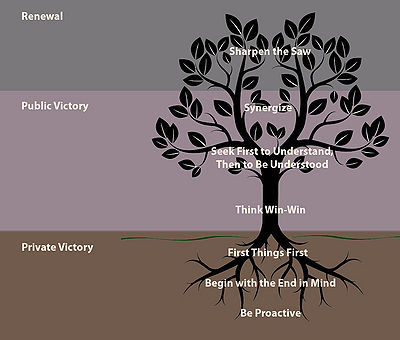The seven characteristic principles
In the light of the modern technology world we live in today it has become more complex, stressful, and demanding for us humans. Especially when one must find a balance between work, family and your own self. For one to achieve higher aspirations and overcome great challenges in once projects and life, Stephan R. Coveys has come up with seven principles. [1]
SStephen R. Coveys approach is an inside- out approach and focus on one’s character ethics which is the foundations of one’s success. The character ethics is about one’s integrity, humility, courage, and modesty. To achieve one’s success and happiness one must look inside with the help from the seven principles. To achieve greatness, you must plant the seeds and work with your own self. [2]
This article presents the seven approaches to help one with becoming more effective in reaching one’s goals. It is all about aligning oneself based on one’s characteristic ethics to achieve one’s goals. The article covers the seven principles and their limitations, connecting the dots and its practical relevance in project management.
Contents |
Context

What are habits?
To understand the seven habits, one must first understand what habits means to having a successful project or work team. Habits are rituals and behaviors we as humans do automatically without thinking about it. Habits are connected to an activity e.g. brushing one’s teeth [3]. To incorporate or change a habit one must have an open mind for it to happen. An equally important thing you need to have in order to change or adapt a habit are the following three things: knowledge, skill, and desire. Knowledge is the question one must ask what to do and why. The skill is where one should ask how to do. Desire is wanting to do. Changing a habit or adapting one can be hard and therefore it is important that you are motivated or have a greater purpose for why.
When incorporating the seven habits from Stephan Coveys you can divide them into three criteria, the Private Victory, Public Victory and Renewal. The Private Victory is all about working on yourself and understanding how you can become a better project manager. Understanding and working on yourself will give you the boost that is necessary to achieve greatness. It is all about going from being dependent to independent. The Public Victory is what Stephen Coveys calls the maturity continuum, which consists of three levels of dependence, independence and interdependent. Dependence is the relationship between a boss and the employer and their attitude towards each other. Going from dependence to independence means you need to understand the first three habits to become the I. The interdependence is where you will be thinking like a team and not about the I to accomplice the goals or scopes set. The interdependence phase will be described in habit four to six.

The 7 Habits of Highly Effective People by Stephen Covey
Introduction: What are habits?
POSS. an introduction that lead to the seven principles
1. Be proactive
Take responsabilyty for your own life
2. Begin with the end in mind
3. First things first
4. Think win-win
5. Seek first to understand, then to be understood
6. Synergize
7. Sharpen the saw: Growth
Limitations
Connecting the dots
Conclution
Annotated Bibliography
Guide to the Project Management Body of Knowledge
THE STANDARD FOR PORTFOLIO MANAGEMENT
References
- ↑ 1.0 1.1 Covey, Stephen R.;The 7 Habits of Highly Effective People, Simon & Shuster, 2nd ed. 2004, p.48 ISBN 978-0-6848-5839-5
- ↑ https://www.youtube.com/watch?v=WFc08j9eorQ
- ↑ https://www.thepositivepsychologypeople.com/habits-to-happiness/
- ↑ Covey Sean; The 7 Habits of Highly Effective People, The Ultimate Teenage Success Guide, Simon & Schuster, 1nd ed. 2014, ISBN13:9781476764665